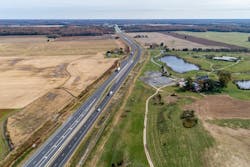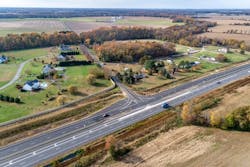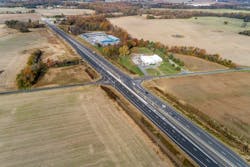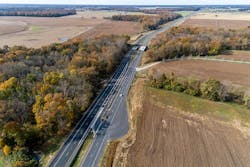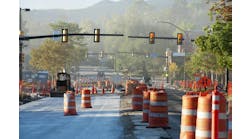Maryland Route 404 (MD 404) is a major highway on Maryland’s Eastern Shore. Anyone who has driven along the Chesapeake Bay Bridge and toward the beaches of Maryland and Delaware is intimately acquainted with this roadway: It services workday commuters and commercial trucks; members of the farming community, who move grain and farming equipment through the corridor; and, of course, summer vacationers.
During peak summer travel periods, traffic volumes can increase formidably. In 2017, an estimated 16,400 vehicles traveled along MD 404 each day; however, in the summer, that number grew to more than 20,150 vehicles—a 20% increase on an already overburdened corridor. Backups could stretch for miles. By 2035, average daily traffic on the MD 404 will increase to 21,900 vehicles per day, and up to 26,900 vehicles during summer months.
Creating a safer, more easily navigated corridor was a top priority for Queen Anne, Talbot, and Caroline counties. For years, the Maryland DOT State Highway Administration (MDOT SHA) studied ways to upgrade MD 404 for safety enhancements that would curtail the crash rates and make travel along the route more efficient and reduce or eliminate delays. The existing two-lane facility was operating at substandard levels of service during the summertime peak traveling hours. Corridor-wide collision rates were nearly twice the statewide average for similar highways: From 2005 to 2014, there were 402 recorded crashes with 12 fatalities.
In 2015, Maryland Gov. Larry Hogan directed MDOT SHA to initiate a project that would balance all these needs by opening four travel lanes across MD 404. However, the popularity and prevalence of this route meant that travelers—as well as residents and commercial interests—could not be inconvenienced or impacted for too long. The Hogan administration set a clear deadline: The project had to be substantially completed—i.e., the new four-lane roadway was to be fully opened, all intersections were to be fully open, and all safety features were to be installed—by Nov. 21, 2017.
For years, MDOT SHA studied ways to upgrade MD 404 for safety enhancements that would curtail crash rates and make travel along the route more efficient, and reduce or eliminate delays. The existing two-lane facility was operating at substandard levels of service during summertime peak traveling hours. A project was initiated in 2015 to balance all the corridor needs by opening four travel lanes across MD 404.
DIVIDING INTO SEGMENTS
In April 2016, MDOT SHA turned to one large team—the 404 Corridor Safety Constructors (404 CSC) Design-Build Team (DBT), which consisted of the general contractor joint venture of Wagman Heavy Civil Inc.; David A. Bramble Inc.; and Allan Myers MD Inc. Wagman served as the managing partner of the 404 CSC DBT. The joint venture design team included Wallace, Montgomery & Associates LLP (WMA); Johnson, Mirmiran & Thompson Inc. (JMT); and Rummel, Klepper & Kahl LLP (RKK). The CSC DBT was tasked with designing and developing an approach to dualize the MD 404 along its existing alignment—in under 18 months. The 404 Corridor Safety Constructors provided MDOT SHA with the best value by saving the state over $40 million.
The administration had a number of other stipulations: The project team would have to deliver their work at or below the budget; ensure that roadways were safe during and after construction; minimize delays during and after construction; and, first and foremost, deliver a project concept, design, and execution that satisfied all the project stakeholders and customers—which included everyone from state government officials; various regulatory agencies; county business leaders; the farming community; and the roadway users who relied on MD 404.
The team had a collective knowledge of the MD 404 corridor and redundant local construction resources. They divided the project construction into three segments: A, B, and C. David A. Bramble constructed Section A, Wagman Heavy Civil constructed Section B, and Allan Myers constructed Section C. These divisions were based on each team member’s strengths; for instance, Wagman’s work on Section B relied on its specialization in bridge construction. This process facilitated continuous, concurrent construction activities. “We were faced with a mission that nobody in the industry thought possible,” explained Tom Heil, director of design-build at Allan Myers. “We formed a team to capture the best of design and construction. The team communicated internally, with the state, and with stakeholders about the project’s processes and any relevant issues. Through partnering, what was impossible became probable and people got excited about it.” Governor Hogan was one of those people, and his office provided the DBT with all the resources they needed.
Eric Sender, senior associate for the Highway Engineering Department at Wallace Montgomery (WM), said, “We implemented a comprehensive ‘rolling’ design and construction process that relied on each team member’s unique expertise to work smarter and more efficiently in terms of ordering materials; mobilizing work forces; and providing continuous work efforts for grading, structures and storm drain culverts and systems, and pavements with each project segment.” Sender added that the “rolling” design submission process also helped to expedite agency reviews and approval, especially for environmental concerns, stormwater management (SWM), and erosion and sediment control. WM was responsible for the design’s overall management and developing designs and plans for corridor-wide waterway crossings and traffic features. JMT oversaw the roadway and drainage designs for Sections A and B. RKK developed the roadway and drainage designs of Section C.
The DBT committed to a partnering process because they knew it was essential to delivering this fast-paced project safely. Once the project was awarded, MDOT SHA, the DBT, and project stakeholders held a kick-off meeting where they developed a partnering charter that went beyond the original mission and goals. The charter outlined methods for escalating and resolving issues; alleviating delays, especially for right-of-way procurement and utility relocations; tracking progress; ensuring construction safety; establishing a clear schedule for check-ins; and monthly partnering meetings to assess progress and preemptively identify areas of focus and concern; cultivating a process for holding high-level and specialized meetings to resolve any design and scheduling conflicts; as well as developing a monthly survey to track communication efforts across the project. Establishing communication and coordination protocols in tandem with design and construction approaches integrated partnering into every aspect of the work process. For Greg Andricos, president and COO of Wagman Heavy Civil, “this project exemplifies the benefits of design-build to accelerate project delivery.”
The 404 Corridor Safety Constructors were tasked with designing and developing an approach to dualize the MD 404 along its existing alignment—in under 18 months.
A COORDINATED EFFORT
MDOT SHA and the DBT determined that the best approach would be to provide the two additional lanes along the existing alignment to create the dualized divided four-lane highway and to incorporate 13 J-Turn and two continuous Green-T intersections. The approach also eliminated left-turn and crossover movements from the connecting side streets and potential conflicts with MD 404 mainline motorists. The DBT’s guiding principles could be encapsulated in two words: accountability and transparency. Each member of the team, from the partners in charge of various disciplines to the design engineers to the contractors on the ground, understood exactly what their roles entailed and what the entire team expected of them. The DBT held weekly “look-ahead” meetings, along with the monthly partnering and follow-up progress meetings, that were fully open to any/all stakeholders. The DBT used a discipline-focused partnering approach to coordination: Working task groups regularly coordinated right-of-way acquisitions, SWM and ESC clearance, environmental permitting compliance, and utility relocations.
“The project was successful because the entire team—contractor, owner, designers, and third-party stakeholders—all worked together,” said Anthony Bednarik, vice president of major pursuits/design-build for Wagman, who served as the design-build project manager for the JV. “Partnering, collaboration, and teamwork were keys to success.”
The project required facilitating an intricate environmental stewardship effort: Its position on the Eastern Show meant that work could potentially impact the Chesapeake Bay and some surrounding streams and tributaries. MD 404 is designated as a hurricane evacuation route for the Delmarva Region. The new MD 404 roadway has upsized waterway culvert crossings to eliminate roadway flooding during 100-year storm events. However, the increased culverts’ conveyance created the potential for stormwater degradation in the downstream channels during smaller storm events. The DBT’s stormwater management approach provided water quality treatment in micro-scale practices, such as bio-swale, wet-swale, and enhanced grass swale facilities along the roadway, instead of concentrating the treatment in end-of-line ponds. This approach also incorporated additional hydraulic control weir structures within the microscale processes, and at the roadway cross culverts, to treat the potential downstream channel stormwater degradation. By maximizing the roadside microscales practices, the DBT minimized the project’s footprints and treated 12.7 more acres of imperious areas than the project required.
Balancing these logistical and environmental needs in a time-efficient way seems tricky enough, but the MD 404 project had a unique human factor that the project team needed to account for as well. As Rob J. Marchetti, P.E., senior manager of transportation engineering for McCormick Taylor, who served as the consultant MDOT SHA design-build manager, explained, “During preliminary design and RFP development, MDOT SHA partnered with the adjacent landowners and farming community. We met with them individually to help understand their needs for the design of the J-turn intersections. MDOT SHA also had to partner with the community about the right-of-way that we needed to acquire to meet the new stormwater management regulations in Maryland.” These community members, many of whom lived in the corridor for generations, needed to support the project’s objectives for the work to be successful. The team had to show creativity and flexibility to ensure that the community could ultimately rally behind the final design.
Bimonthly coordination meetings helped to streamline and balance the utility relocations with the roadway, grading, and drainage designs—which proved vital to the project’s overall success, given that, in many of the project locations, right-of-way was limited. These constraints presented considerable obstacles in fitting all the design deliverables—SWM ditches, diversion and bypass ditches, utilities, and access paths—within these locations. The collective length of drainage ditches and SWM swales were the length of a marathon and a 5K combined.
The DBT and MDOT SHA included project management members, design staff, and field representatives at every stage of project development. Each discipline could respond to any potential issues and challenges because they were kept thoroughly, and consistently, informed throughout the process. Team leaders spearheaded carefully structured and focused meetings that followed strategically developed agendas. Each meeting ended with clear discussions and delegations of action items, which the DBT tracked via an action item log. As Marchetti put it, “partnering helped expedite the project delivery because it helped make additional staff and resources available to complete the design and obtain all permitting approvals for construction to commence.”
This collaborative spirit was also evident in the granular, day-to-day level of project work. The construction venture had office spaces adjacent to MDOT SHA’s field personnel, which deepened and strengthened the working relationships between the teams, not only in more formal collaborations, but in informal communications through daily discussions between MDOT SHA’s engineers and inspectors, and the DBT’s construction manager, project managers and engineers, and superintendents. Often, the DBT representatives would begin their work days by sharing information about the project plans and updates with MDOT SHA. Consistent communication ensured that the DBT had a clear understanding of MDOT SHA’s expectations. This understanding, in turn, reduced field issues and rework. It also made work safer for contractors and motorists alike. No motorists were injured in the work zone throughout construction, and the DBT’s vigorous safety program achieved a MDOT “A” rating for safety.
MDOT SHA and the DBT determined that the best approach would be to provide the two additional lanes along the existing alignment to create the dualized divided four-lane highway and to incorporate 13 J-Turn and two continuous Green-T intersections.
SEEING IT THROUGH
The MD 404 project represented an innovative combination of three local contractors and design engineering firms, who pooled their considerable talents and resources to concurrently complete design and construction across a complex project area. During the ribbon cutting ceremony, Gov. Hogan expressed his administration’s pride in the project success, saying, “With the completion of the MD 404 upgrade, our administration is proud to deliver on the number one priority for Queen Anne’s, Talbot, and Caroline counties—completed a year and a half ahead of schedule.”
One of the most powerful voices at the ceremony belonged to Marie Freeman, whose 10-month-old daughter, Brianna Nicole, died after a collision on MD 404, just east of where that ribbon cutting was held. Mrs. Freeman praised the Hogan administration, MDOT SHA, and the project team for their work to make the highway safer and more usable. “It was time to see this project to the end,” she said. In a single construction season, MDOT SHA and the 404 CSC DBT “delivered what we had waited for … a safe, four-lane divided highway.”
